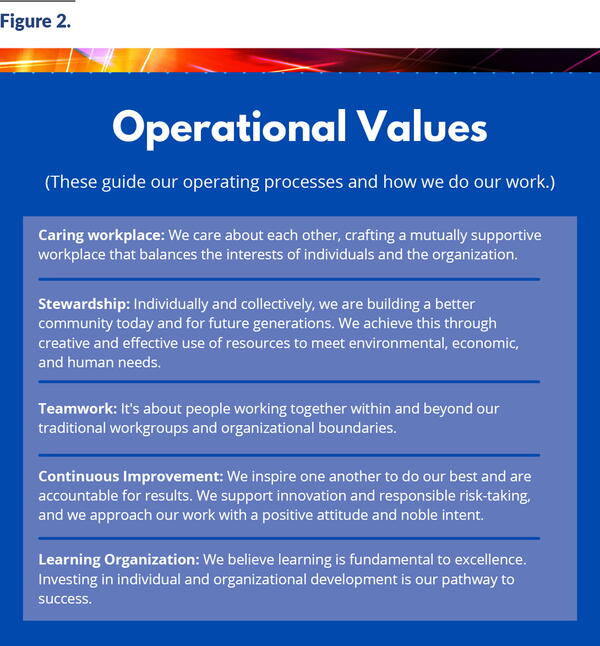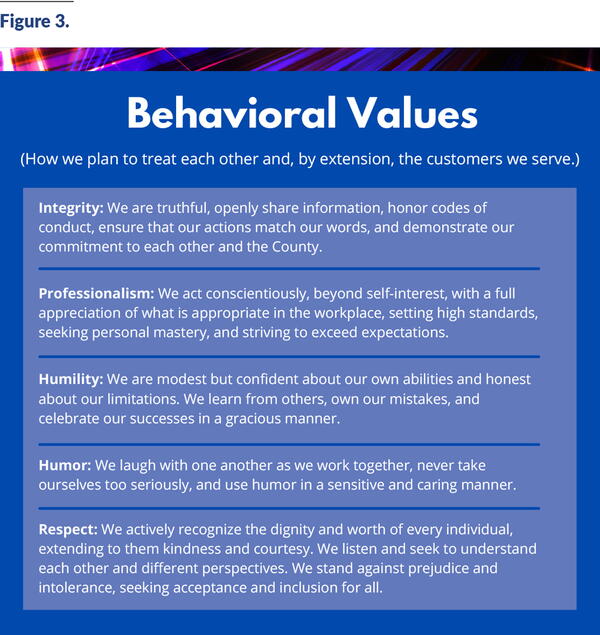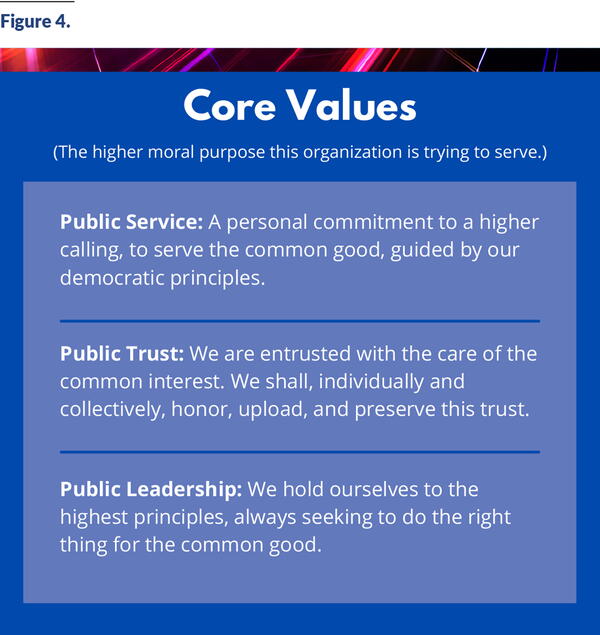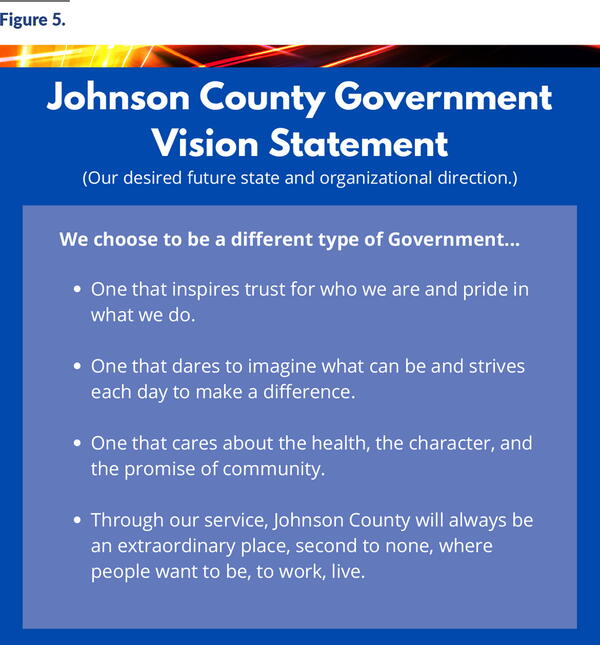
Over the last three issues of PM magazine, we have said that high performance is a habit of continuous improvement; that our beliefs about people and work and their impact upon culture matter; and that high performance comes from consultative or participative practices, according to Likert’s four management systems. In this issue, we look at the work of leadership.
Leadership—What You Do Does Matter
A culture of higher performance will not create itself. Recalling the change model introduced in the June 2021 issue,1 an organization can be viewed in two parts: (1) the production side, where management exerts controls for consistent, predictable production; and (2) the cultural side, where leadership determines how the organization operates. See Figure 1.

Culture develops through leadership work and cannot simply be practiced at the top of the hierarchy. It needs to be a shared responsibility of everyone in the organization. Just like technical skills, leadership is a set of practices to be exercised every day.
Leadership and Its Daily Practices
We all sense the importance of leadership, yet there is no common understanding of exactly what it is.2 For us, leadership is not hierarchical. It is not a position or authority. Indeed, we carefully distinguish the terms leadership and leader, since “leader” too often connotes one who is “in charge.”
Leadership, we believe, is the capacity to influence the beliefs, behaviors, and purposeful actions of others for a common good. It is people-centric, exercised in the context of personal connection and relationships. Leadership is less about telling and more about inspiring and engaging others. It is doing the right thing for the right reasons for the greater good. We all have the capacity to do that effectively; doing so is a choice we make. For higher performance, we must each exercise leadership within our own job responsibilities, “leading from where we sit” in the organization.

The Management Conundrum
For some, management and leadership are just two ends of a continuum. To be sure, those in management must exercise leadership, and those who exercise leadership must do management. However, management and leadership are two vastly different things.3
Management is intended to organize, to produce order and consistency, using rules and restrictions to control. It is tactical, concerned with the practical application of know-how.
Leadership, on the other hand, is strategic, oriented around what should be and why. It is intended to inspire action, to produce adaptive change and growth through ideals and meaningful purpose, relying upon values and principles for control.
We manage things and processes. We lead people and relationships, for adaptive growth, and to create potential.

The Organization’s Work of Leadership
In his book, Turn the Ship Around!, L. David Marquet asserts that leadership is more about getting people to think rather than to do. Getting workers to think like a captain (or manager) enables them to do their job better without orders or controls. It shifts responsibility to where the knowledge and technical skills are. The key to doing so, according to Marquet, is the leadership work of building clarity and competence across the organization.
For us, the work of leadership covers a wider range of strategic practices, including:
- Building organizational culture and clarity.
- Developing organizational capacity and competence.
- Building strategic adaptability and change readiness.
- Ensuring strategic alignment and cultural integrity.
- Building relationships and interdependence.

Cultural Clarity
The culture of an organization shows up in its norms and habits, in its relationships and behaviors, in its symbols and artifacts. It has impact when people feel inspired that their work has meaning.
The work of leadership defines the culture, gives clarity to its meaning, and makes it a daily living movement in the work of the organization. We define culture by articulating a shared purpose (why we exist), vision (the lofty ideal we seek to be), philosophy (beliefs about people and work), and values (how we will behave, treat others, and work together). Figure 5 shows the vision and values for Johnson County, Kansas.

Developing and articulating the vision and values is only the beginning of the leadership work. Clarity comes from defining what the vision and values actually mean. It comes from constant, daily discussion and application. It is asking whether your actions are consistent with your values—whether they serve the vision. In other words, is it the right thing to do, tested by our vision and values?
Culture happens when the people in the organization can tell you what the vision means, what the values are, and what they mean to them. Leadership is evident when those questions and discussions routinely occur at all levels throughout the organization.
Competence and Capacity
Competence and capacity determine whether the organization is making the best use of its available resources. How do we find and develop talent and capability already in our organization? How do we help people grow and develop beyond a job description? How do we create an environment where people choose to invest their discretionary time, energy, excitement, and knowledge?
First, everyone doing leadership at all levels should be maximizing consultative and participative management practices, seeking input and suggestions, and involving others in open discussion and thoughtful debate.
Second, we empower and enable others by moving responsibility and decision-making to where the information and activity are. We move people around, allowing them to see the work from different viewpoints. We find areas of interest and create challenging opportunities for them to experience.
Third, we make learning an organizational value. Leadership does not tell or teach per se, rather it inspires curiosity and raises expectations for learning, it causes engagement by inviting people to grow and develop, meet their potential, seek mastery.
Finally, we set aside work time for individual and group thinking, communicating, coaching, and sharing. We set a standard that doing their jobs requires learning something new and sharing it with others.
Adaptability and Readiness for Change
The essence of public service is leaving the community better than we received it. We cannot accomplish that by simply doing the same things that we have always done. The pace of change continues to increase. Thus, our organizations must become more agile, adaptable to new conditions and challenges, while retaining the community character cherished by the residents.
The work of leadership does not rely upon “best practices” copied from others. Rather, it pursues strategic thinking and relationships with others to develop and implement creative approaches and new ways of thinking. It removes the negative, doubtful “we cannot do that” or “it won’t work here” thinking and invites creative “what if” thinking. It places value upon questions as much as on answers.
The work of leadership does not avoid change. It emphasizes growth, development, and adaptation. It prepares the organization for “new” and “different” by being receptive to experimentation and establishing work teams to review and evaluate ideas and improvements. In Johnson County, Kansas, an employee group set up a program called Project Impact, which invited, reviewed, experimented, and evaluated suggestions and new ideas from across the organization. Scores of ideas have been submitted, and many have been successfully implemented.
Alignment and Integrity
The work of leadership ensures that the organization has and maintains integrity with its culture and its operating strategies, structures, and systems. We cannot ask employees to share and perform according to a set of values if we operate by contrary rules. Alignment does not happen just on organization-wide systems; it must happen also with each normal work practice, rule, and process. The work of leadership constantly reviews and evaluates, seeks input, and listens to suggestions about the strategies, structures, and systems, asking whether they serve or conflict with the cultural values, and then it makes changes and updates as necessary.
Interdependence and Stewardship
An old saying goes, “Leadership not only sets the course, it gets people on the boat and rowing together.” We know that teamwork and collaboration improve performance substantially, but “rowing together” goes beyond structured teams. How do we get people to join us on the boat? To energetically row with us? To stay the course?
We do so with the work of leadership, moving away from the hierarchy and its rigidity to a more flexible network structure built around team skills and facilitative leadership. We do so by building interdependence, blending talents together like a symphony to create a more powerful whole. We do so by developing consultative/participative practices that invite people to be a part of something bigger than themselves and empowers them to participate fully and safely. We do so with stewardship, protecting and caring for the “symphony” as a shared responsibility.
Next
Next month, we will look at ways to create time and place for performing the work of leadership and how to adaptively change organizational habits using a parallel organization.

DON JARRETT is an instructor for the University of Kansas School of Public Affairs and Administration. He has over 40 years of professional experience in local government, serving as the chief legal counsel for Johnson County for 35 years before retiring in 2020. (don.jarrett@ku.edu).

PATTY GENTRUP is the consulting services manager for the University of Kansas Public Management Center. She has been in direct service or as a consultant for local governments for 30 years, including six years as a city administrator. (patty.gentrup@ku.edu).
Endnotes and Resources
1 Pickering and Matson, Why Executive Development Programs Alone Don’t Change Organizations, (1992).
2 See the summary at Appendix 2, Stephen R. Covey, The 8th Habit (2004).
3 A useful summary of viewpoints on leadership/management can be found in Appendix 3, Stephen R. Covey, The 8th Habit (2004).
New, Reduced Membership Dues
A new, reduced dues rate is available for CAOs/ACAOs, along with additional discounts for those in smaller communities, has been implemented. Learn more and be sure to join or renew today!
